Musée Carnavalet, Paris
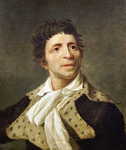
Portrait of Jean-Paul Marat (1743-1793), Joseph Boze
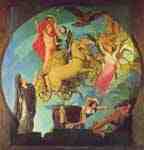
Apotheosis of Napoleon I, Jean Auguste Dominique Ingres
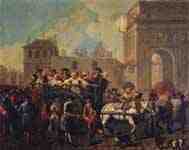
Transport of prostitutes to police station, Étienne Jeaurat
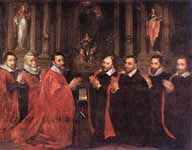
The Échevins of Paris Praying before St Genevičve, Georges Lallemand
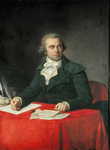
Portrait of Jules François Paré, Jean-Louis Laneuville
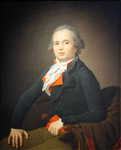
Portrait of Louis Legendre (1756-1797), Jean-Louis Laneuville
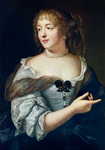
Portrait of Marie de Rabutin-Chantals, Marquise de Sévigné, Claude Lefebvre
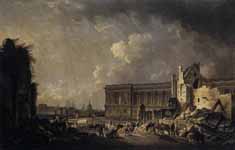
Clearing the Area in front of the Louvre Colonnade, Pierre-Antoine de Machy
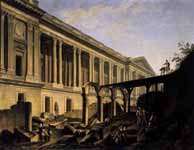
Clearing the Area in front of the Louvre Colonnade, Pierre-Antoine de Machy
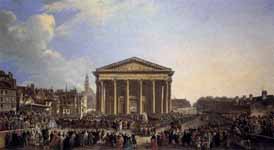
Official Laying of the Cornerstone of the New Church of Sainte-Genevičve, Pierre-Antoine de Machy
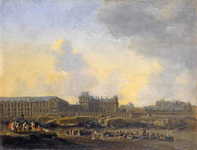
The Louvre and the Hôtel de Bourbon, seen from the left bank, Reinier Nooms
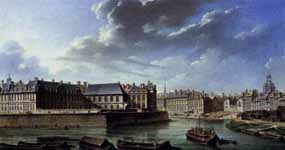
The Eastern Tip of Ile Saint-Louis, Nicolas-Jean-Baptiste Raguenet
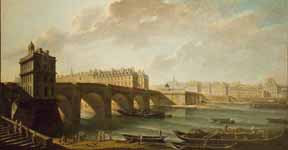
The Pont Neuf and the Samaritaine, Nicolas-Jean-Baptiste Raguenet
The Carnavalet Museum in Paris is dedicated to the history of the city. The museum occupies two neighboring mansions: the Hôtel Carnavalet and the former Hôtel Le Peletier de Saint Fargeau. On the advice of Baron Haussmann, the civil servant who transformed Paris in the latter half of the 19th century, the Hôtel Carnavalet was purchased by the Municipal Council of Paris in 1866; it was opened to the public in 1880. By the latter part of the 20th century, the museum was bursting at the seams. The Hôtel Le Peletier de Saint Fargeau was annexed to the Carnavalet and opened to the public in 1989.[2]
Carnavalet Museum is one of the 14 City of Paris' Museums that have been incorporated since January 1, 2013 in the public institution Paris Musées.
Collections
In the courtyard, a magnificent sculpture of Louis XIV, the Sun King, greets the visitor.[3] Inside the museum, the exhibits show the transformation of the village of Lutèce, which was inhabited by the Parisii tribes,[4] to the grand city of today with a population of 2,201,578.[5]
The Carnavalet houses the
following: about 2,600 paintings, 20,000 drawings, 300,000 engravings
and 150,000 photographs, 2,000 modern sculptures and 800 pieces of
furniture, thousands of ceramics, many decorations, models and reliefs,
signs, thousands of coins, countless items, many of them souvenirs of
famous characters, and thousands of archeological fragments. ... The
period called Modern Time, which spans from the Renaissance until
today, is known essentially by the vast amount of images of the city.
... There are many views of the streets and monuments of Paris from the
sixteenth to the twentieth century, but there are also many portraits
of characters who played a role in the history of the capital and works
showing events which took place in Paris, especially the many
revolutions which stirred the capital, as well as many scenes of the
daily life in all the social classes.[6]
Lutetia
Long narrow canoes made from a single tree trunk (pirogues), dating
back long before the first written description of the village (known at
the time as Lutèce) in A.D. 52 in Julius Caesar’s De bello Gallico[7][8]
A beautiful fourth-century bottle used for perfume, wine, or honey[9]
The Medieval city
Scale model of the Île de la Cité in the 16th century
An ornate chest from the 13th century, which probably came from the royal Abbey of Saint Denis[10]
A well-preserved 14th-century sculpture of the head of the Virgin Mary,
peaceful and contemplative, despite the tumultuous events that
decimated the city at that time: the Hundred Years' War and the Great
Plague of 1348[11]
The Renaissance and Wars of Religion
Paintings from the 16th century depicting famous men and women of the
time, including Francis I, Catherine de' Medici, and Henry IV.[12]
A painting of the Pont Neuf in about 1660 showing Parisians on
horseback or on foot. A vendor is showing his wares to a crowd of
interested on-lookers, and a man is walking hunched over with a bundle
on his back.[13]
Several paintings of Madame de Sévigné, who was considered the most beautiful woman in Paris[14]
The French Revolution
La Fête de la Fédération, le 14 juillet 1790, au Champs de Mars, Charles Thévenin (1764–1838)
The famous uncompleted painting by Jacques-Louis David, The Tennis
Court Oath (1789), portraying a pivotal event in French history when
members of the National Assembly swore an emotional oath that they
would not disband until they had passed a “solid and equitable
Constitution.“[15] This event is often regarded as the beginning of the
French Revolution.
Paintings showing the people’s revenge on the
Bastille, a dungeon that had become “a symbol of the arbitrariness of
royal power.”[16]
Paintings or sculptures of the famous actors in the drama of the
Revolution, including Mirabeau, Danton, Robespierre, and the royal
family[17]
A painting of death by guillotine at the Place de la Révolution, by
Pierre-Antoine Demauchy: the fate that struck King Louis XVI, Queen
Marie Antoinette, the Royalists, the Girondins, the Herbertists, the
Dantonists, Robespierre and his followers, and many others[18]
Personal effects belonging to Marie-Antoinette.[19]
A paper on which Robespierre had partially written his signature when
he was seized by soldiers of the National Convention.[20]
Paris, Capital of the Nineteenth Century
Le Marché et la Fontaine des Innocents (1822), John James Chalon (1778–1854), Musée Carnavalet
Napoleon’s favorite case of toiletries[21]
Paintings of early-19th-century Paris[22]
A painting depicting one of the most important moments of the July
Revolution: The Seizing of the Louvre, 29 July 1830, by Jean-Louis
Bézard[23]
Marvelous sculptures of Parisians of the time, some realistic portrayals, others caricatures, by Jean-Pierre Dantan[24]
The ornate cradle of the imperial prince, Louis Napoleon Bonaparte, son
of the Emperor Napoleon III and the Empress Eugénie[25]
Illustrated posters from the Belle Epoque[26]
Realistic paintings of late 19th-century Paris.[27]
A gold watch-chronometer that belonged to Émile Zola
A painting of the construction of the Statue of Liberty, which was shipped to the United States in pieces[28]
Paintings of the Exposition Universelle, including one of the Eiffel
Tower, which was specifically built for this event. It was used in the
1970 Walt Disney animated film "Aristocats".
Paris in the twentieth century
Après l'office à l'église de la Sainte-Trinité, (around 1900), Jean Béraud (1849–1935)
A reconstruction, with original furniture, of the room where Marcel Proust wrote In search of lost time[29]
Photographs of 20th-century Paris by Eugène Atget and Henri Cartier-Bresson[30]
A stylized painting of a crowded bistro of the mid-1900s, by the naturalized Japanese artist, Leonard Foujita[31]
A photograph in daguerreotype, The Forum of the Halles, taken by two
American photographers in 1989 for an exhibit at the Carnavalet
celebrating the 150th anniversary of the invention of photography[32]
The present buildings
Hôtel de Carnavalet
In 1548, Jacques des Ligneris, President of the Parliament of Paris, ordered the construction of the mansion that came to be known as the Hôtel Carnavalet; construction was completed about 1560. In 1578, the widow of Francois de Kernevenoy, a Breton whose name was rendered in French as Carnavalet, purchased the building. In 1654, the mansion was bought by Claude Boislève, who commissioned the well-known architect, François Mansart, to make extensive renovations. Madame de Sévigné, famous for her letter-writing, lived in the Hôtel Carnavalet from 1677 until her death in 1696.[33]
Hôtel Le Peletier de Saint Fargeau
The Hôtel Le Peletier de Saint Fargeau was also built in the middle of the 16th century. It was originally known as the Hôtel d’Orgeval. It was purchased by Michel Le Peletier and passed on eventually to his grandson, Le Peletier de Saint Fargeau was a representative of the nobility in the Estates-General of 1789. In 1793, Le Peletier voted for the execution of Louis XVI, and was murdered, in revenge for his vote, the same day of the execution of the king on January 20, 1793.[34]
See also
List of museums in Paris
References
"Palmarès 2011 des musées ", Le Journal des Arts, n°350, 24 juin 2011, p.23
Leri, Jean-Marc,Musée Carnavalet: Histoire de Paris, pages 7-8.
Leri, Jean-Marc,Musée Carnavalet: Histore de Paris, page 41.
Colson, Jean, Paris: Des origines à nos jours, page 11.
"La population par arrondissement de 1990 à 2009". Paris.fr: (Mairie de Paris). Retrieved 2009-02-13.
Leri, Musée Carnavalet: Histoire de Paris, pages 11-12.
Colson, Jean, Paris: des origines à nos jours, page 10.
Leri, Musée Carnavalet: Histoire de Paris, page 14.
Leri, Jean-Marc, Musée Carnavalet: Histore de Paris"", page 19.
Leri, Musée Carnavalet: Histore de Paris"", page 20.
Colson, Jean Paris: des origines à nos jours, pages 25-27.
Leri, Jean-Marc, Musée Carnavalet: Histoire de Paris, pages 21-23.
Leri, Musée Carnavalet: Histore de Paris, page 36.
Leri, Jean-Marc, Musée Carnavalet: Histoire de Paris, page 47.
Schama, Simon Citizens: A Chronicle of the French Revolution, page. 359.
Leri, Jean-Marc, Musée Carnavalet: Histoire de Paris, page 97.
Leri, Jean-Marc Musée Carnavalet: Histoire de Paris, pages 98-102.
Leri, Jean-Marc, Musée Carnavalet: Histoire de Paris, page 47.
Personal visit to museum, 2005-01-02.
Interview with museum guard, 2005-01-02.
Leri, Jean-Marc, Musée Carnavalet: Histoire de Paris, page 110.
Leri, Jean-Marc, Musée Carnavalet: Histoire de Paris, pages 140-141; 126-127; 137; 139.
Leri, Jean-Marc, Musée Carnavalet: Histoire de Paris, page 123.
Leri, Jean-Marc, Musée Carnavalet: Histoire de Paris, pages 13-131.
Leri, Jean-Marc, Musée Carnavalet: Histoire de Paris, page 147.
Jean-Marc, Musée Carnavalet: Histoire de Paris, page 159.
Leri, Jean-Marc, Musée Carnavalet: Histoire de Paris, pages 140-141; 148-157; 159-163.
Leri, Jean-Marc Musée Carnavalet: Histoire de Paris, page 168.
Leri, Jean-Marc,Musée Carnavalet: Histoire de Paris, page 172.
Leri, Jean-Marc, Musée Carnavalet: Histoire de Paris, page 178-179; 186; 188-189,
Leri, Jean-Marc,Musée Carnavalet: Histoire de Paris, page 187.
Leri, Jean-Marc, Musée Carnavalet: Histoire de Paris, page 190.
Leri, Jean-Marc,Musée Carnavalet: Histoire de Paris, pages 7-9.
Leri, Jean-Marc,Musée Carnavalet: Histoire de Paris, pages 10-11.
Bibliography
Colson, Jean. Paris: Des Origines à Nos jours. Paris: Éditions Hervas, 1998.
Leri, Jean-Marc. Musée Carnavalet: Histoire de Paris. Paris:Éditions Fragments International, 2007.
Schama, Simon. Citizens: A Chronicle of the French Revolution. New York: Alfred A. Knopf, 1989.
"Taking in Paris Any Day, Any Century". New York Times. January 9, 2013.
----
Fine Art Prints | Greeting Cards | Phone Cases | Lifestyle | Face Masks | Men's , Women' Apparel | Home Decor | jigsaw puzzles | Notebooks | Tapestries | ...
----
Artist
A - B - C - D - E - F - G - H - I - J - K - L - M -
N - O - P - Q - R - S - T - U - V - W - X - Y - Z
Retrieved from "http://en.wikipedia.org/"
All text is available under the terms of the GNU Free Documentation License


